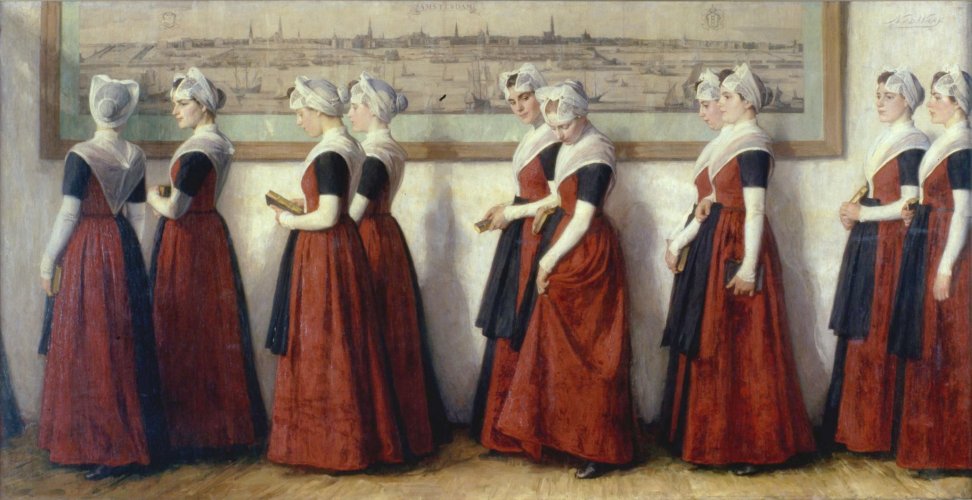Description:
“The Amsterdam Orphans” by Nicolas van der Waay (1855-1936) belong to a considerable group of works by the artist where he portrayed the wards of Amsterdam’s orphanage during their daily activities*. In this, his largest work, he depicted young girls walking in pairs to the left. Their characteristic red-black dresses with white accents, as well as the sepiabackdrop of old Amsterdam with the city and Kingdom of Holland’s coat of arms, leave no doubt as to whom we are looking at. The identical prayer books in their hands indicate that they are either heading or returning from the municipal orphanage chapel or from their Sunday long procession to the Protestant Church at Prinsengracht or to the Nieuwe Kerk at the Royal Palace**.
A photograph from 3 March 1903 showing van der Waay finishing the painting in question points to an unknown, exact time of its creation***. Presumably in the same period the artist created a somewhat smaller, reversed version of this composition, in which the same orphans are headed in the opposite direction, this time revealing the black side of their symmetrical costumes****.
The painterly qualities of these extraordinary garments had already interested artists, including the German Impressionist Max Liebermann, who in the 1880s, likely under the influence of Isaac Israëls, created several such works***** This Dutch Impressionism promoter also impacted van der Waay’s painting from around 1900**. This is visible in the attempt to capture the changing light and colouristic searches in the Rotterdam and Amsterdam versions of “Orphans”.
Beyond the painting layer, Holen’s paintings carry much deeper content and questions related to social and moral nature. Van der Waay, known for his work for the incoming Queen Wilhelmina, glorified the past of Amsterdam and the Netherlands, while at the same time indicating in them hopes for the development of education and aid to the needy. This was most clearly heard in his project of decorating the so-called golden carriage, a gift from the citizens of the city for this young “Niderlandzkie Dziewicy”. It is with this same way of thinking that we are dealing with in “Amsterdam Orphans”, in which the pride in having an orphanage maintained by the city since the 16th century is combined with the eternal question of the mental condition of the children raised there. As can be seen from the well-kept but also stigmatized by the characteristic costume, or forced to various obligations, which they did not always identify with. This is reflected by the gestures and faces of the procession moving calmly, which “brings to mind the frosts from the princely Italian palaces of the Renaissance”*.


